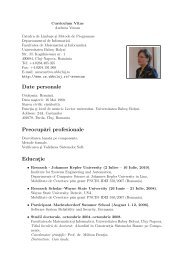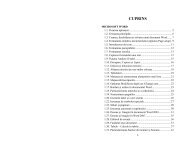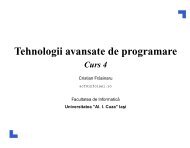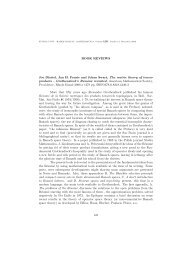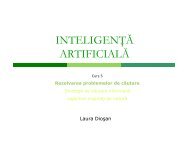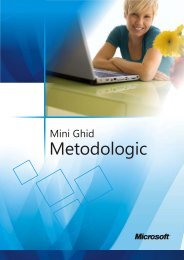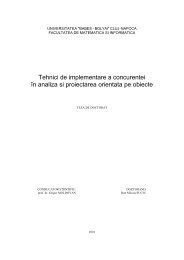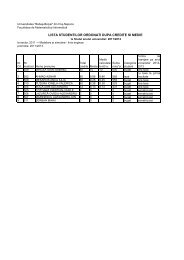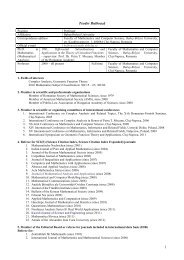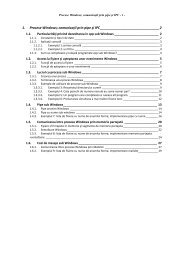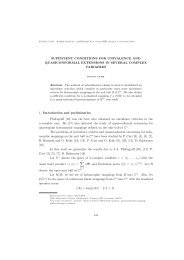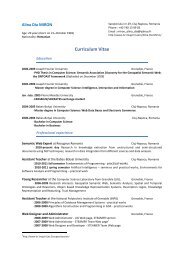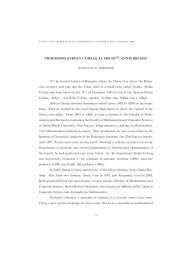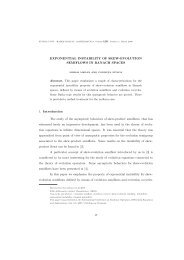CONTENTS
CONTENTS
CONTENTS
Create successful ePaper yourself
Turn your PDF publications into a flip-book with our unique Google optimized e-Paper software.
A PARALLELIZATION SCHEME OF SOME ALGORITHMS 247<br />
3: If the validity conditions are satisfied then i is appended to the sequence of<br />
results.<br />
4: Builds a message with the results and sends it to the dispatcher.<br />
5: end for<br />
Receiving a responce message, the dispatcher verifies whether some solutions are<br />
obtained (i.e. the length of a generated sequence is n). If the generated sequences are<br />
not solutions then the dispatcher push them into the repository.<br />
As initialization, the dispatcher sends a message with the sequence [0] to the first<br />
worker, while the sequences [i], i ∈ {1, . . . , n − 1} are push into the repository.<br />
The quicksort method. The message class contains the rank of the source, a<br />
tag, an index, a splitting index and a sequence.<br />
Let us suppose that at a stage of the quicksort method, the sequence to be sorted<br />
is [x0, x1, . . . , xn−1]. The index of a subsequence [xp, xp+1, . . . , xq] is p. Let us suppose<br />
that the dispatcher sends this subsequence to a worker. The worker split the received<br />
sequence as it is done in the standard quicksort method. If [y0, y1, . . . , yq−p] is the<br />
modified sequence and r is the splitting index, then<br />
yi < yr, ∀i < r and yj ≥ yr ∀j ≥ r.<br />
This sequence will be returned by the worker.<br />
Receiving a response message, the dispatcher update the sequence to be sorted<br />
and if the length of a splited subsequence is greather than 2, then the parameters of<br />
subsequence (the starting index and the length) are pushed into the repository.<br />
References<br />
[1] Z. BAOYIN, 2005, ”Jcluster A Java Parallel Environment.” Docs distributed with the software,<br />
version 1.0.5.<br />
[2] R. BISSELING, 2004, Parallel Scientific Computation. A structured approach using BSP and<br />
MPI, Oxford Univ. Press.<br />
[3] CHENGYAN ZH., 1996, Parallel Quicksort algorithm with PVM optimization. Project report<br />
CS62025. Univ. NewBrunswick, Fac. Computer Science, Fredericton.<br />
[4] HAMADI Y., BESSIÈRE CH., QUINQUETON J., 1998, Backtracking in Distributed Networks.<br />
http://research.microsoft.com/∼youssefh/Papers/ecai98.pdf.<br />
[5] TSIGAS PH., ZHANG Y., 2003, A Simple Fast Parallel Implementation<br />
of Quicksort and its Performance Evaluation on SUN Enterprise 10000.<br />
http://www.es.chalmers.se/∼tsigas/papers/Pquick.pdf.<br />
[6] SNIR M., OTTO D., HUSS-LEDERMAN S., WALKER D., DONGARRA J., 1996, MPI: The<br />
Complete Reference. MIT Press, Cambridge, MA.<br />
[7] SCHEIBER E., 2007, A TSpaces Based Framework for Parallel - Distributed Applications.<br />
Knowledge Engineering Principles and Techniques 1 (2007), Cluj University Press, 341-345.



